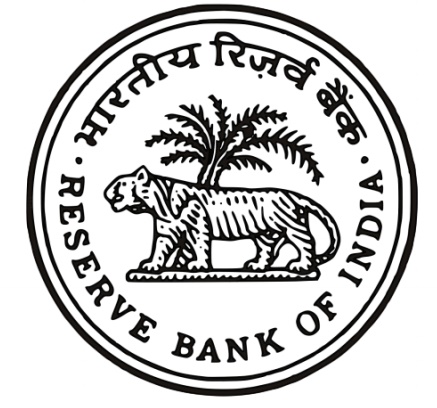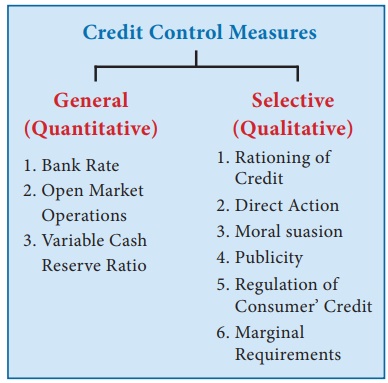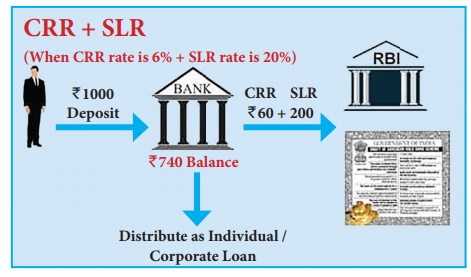Banking - Central Bank | 12th Economics : Chapter 6 : Banking
Chapter: 12th Economics : Chapter 6 : Banking
Central Bank
Central Bank
A central bank, reserve bank, or monetary authority is an
institution that manages a state’s currency, money supply, and interest rates.
Central banks also usually oversee the commercial banking system of their
respective countries.
1. Functions of Central Bank (Reserve Bank of India)
The Reserve Bank of India (RBI) is India’s central banking
institution, which controls the monetary policy of the Indian rupee. It
commenced its operations on 1 April 1935 in accordance with the Reserve Bank of
India Act, 1934. The original share capital was divided into shares of ₹100
each fully paid, which were initially owned entirely by private shareholders.
Following India’s independence on 15 August 1947, the RBI was nationalised on 1
January 1949.

1. Monetary Authority: It controls the supply of money in the
economy to stabilize exchange rate, maintain healthy balance of payment, attain
financial stability, control inflation, strengthen banking system.
2. The issuer of currency: The objective is to maintain the currency
and credit system of the country. It is the sole authority to issue currency.
It also takes action to control the circulation of fake currency.
3. The issuer of Banking License: As per Sec 22 of Banking Regulation Act, every bank has to obtain a banking license from RBI to conduct banking business in India.
4. Banker to the Government: It acts as banker both to the central and
the state governments. It provides short-term credit. It manages all new issues
of government loans, servicing the government debt outstanding and nurturing
the market for government securities. It advises the government on banking and
financial subjects.
5. Banker’s Bank: RBI is the bank of all banks in India as
it provides loan to banks, accept the deposit of banks, and rediscount the
bills of banks.
6. Lender of last resort: The banks can borrow from the RBI by
keeping eligible securities as collateral at the time of need or crisis, when
there is no other source.
7. Act as clearing house: For settlement of banking transactions,
RBI manages 14 clearing houses. It facilitates the exchange of instruments and
processing of payment instructions.
8. Custodian of foreign exchange reserves: It acts as a custodian
of FOREX. It administers and enforces the provision of Foreign Exchange
Management Act (FEMA), 1999. RBI buys and sells foreign currency to maintain
the exchange rate of Indian rupee v/s foreign currencies.
9. Regulator of Economy: It controls the money supply in the
system, monitors different key indicators like GDP, Inflation, etc.
10. Managing Government securities: RBI administers
investments in institutions when they invest specified minimum proportions of
their total assets/liabilities in government securities.
11. Regulator and Supervisor of Payment and Settlement Systems: The Payment and
Settlement Systems Act of 2007 (PSS Act) gives RBI oversight authority for the
payment and settlement systems in the country. RBI focuses on the development
and functioning of safe, secure and efficient payment and settlement
mechanisms.
12. Developmental Role:
This
role includes the development of the quality banking system
in India and ensuring that credit is available to the productive sectors of the
economy. It provides a wide range of promotional functions to support national
objectives. It also includes establishing institutions designed to build the
country’s financial infrastructure. It also helps in expanding access to
affordable financial services and promoting financial education and literacy.
13. Publisher of monetary data and other data: RBI maintains and provides
all essential banking and other economic data, formulating and critically
evaluating the economic policies in India. RBI collects, collates and publishes
data regularly.
14. Exchange manager and controller: RBI represents India as
a member of the International Monetary Fund [IMF]. Most of the commercial banks
are authorized dealers of RBI.
15. Banking Ombudsman Scheme: RBI introduced the Banking Ombudsman
Scheme in 1995. Under this scheme, the complainants can file their complaints
in any form, including online and can also appeal to the Ombudsman against the
awards and the other decisions of the Banks.
16. Banking Codes and Standards Board of India: To measure the
performance of banks against Codes and standards based on established
global practices, the RBI has set up the Banking Codes and Standards Board of
India (BCSBI).
2. Credit Control Measures
Credit control is the primary mechanism available to the Central
banks to realize the objectives of monetary management. The RBI is much better
placed than many of credit control. The statutory basis for the control of the
credit system by the Reserve Bank is embodied in the Reserve Bank of India Act,
1934 and the Banking Regulation Act, 1949.

3. Methods of Credit Control
I. Quantitative or General Methods:
1. Bank Rate Policy:
The bank rate is the rate at which the Central Bank of a country
is prepared to re-discount the first class securities. It means the bank is
prepared to advance loans on approved securities to its member banks. As the
Central Bank is only the lender of the last resort the bank rate is normally
higher than the market rate. For example: If the Central Bank wants to control
credit, it will raise the bank rate. As a result, the deposit rate and other
lending rates in the money-market will go up. Borrowing will be discouraged,
and will lead to contraction of credit and vice versa.
2. Open Market Operations:
In narrow sense, the Central Bank starts the purchase and
sale of Government securities in the money market.
In Broad Sense, the Central Bank purchases and sells not
only Government securities but also other proper eligible securities like bills
and securities of private concerns. When the banks and the private individuals
purchase these securities they have to make payments for these securities to
the Central Bank.
3. Variable Reserve Ratio:
a) Cash Reserves Ratio:
Under this system the Central Bank controls credit by changing the
Cash Reserves Ratio. For example, if the Commercial Banks have excessive cash
reserves on the basis of which they are creating too much of credit,this will
be harmful for the larger interest of the economy. So it will raise the cash
reserve ratio which the Commercial Banks are required to maintain with the
Central Bank.

Similarly, when the Central Bank desires that the Commercial Banks
should increase the volume of credit in order to bring about an economic
revival in the economy. The central Bank will lower down the Cash Reserve Ratio
with a view to expand the lending capacity of the Commercial Banks.
Variable Cash Reserve Ratio as an objective of monetary policy was
first suggested by J.M. Keynes. It was first followed by Federal Reserve System
in United States of America. The commercial banks as per the statute has to
maintain reserves based on their demand deposit and fixed deposit with central
bank is called as Cash Reserve Ratio.
If the CRR is high, the commercial bank’s capacity to create
credit will be less and if the CRR is low, the commercial bank’s capacity to
create credit will be high.
b) Statutory Liquidity Ratio:
Statutory Liquidity Ratio (SLR) is the amount which a bank has to
maintain in the form of cash, gold or approved securities. The quantum is specified
as some percentage of the total demand and time liabilities (i.e., the
liabilities of the bank which are payable on demand anytime, and those
liabilities which are accruing in one month’s time due to maturity) of a bank.
II. Qualitative or Selective Method of Credit Control:
The qualitative or the selective methods are directed towards the
diversion of credit into particular uses or channels in the economy. Their
objective is mainly to control and regulate the flow of credit into particular
industries or businesses. The following are the frequent methods of credit
control under selective method:
1.
Rationing of Credit
2.
Direct Action
3.
Moral Persuasion
4.
Method of Publicity
5.
Regulation of Consumer’s Credit
6.
Regulating the Marginal Requirements on Security Loans
1. Rationing of Credit
This is the oldest method of credit control. Rationing of credit
as an instrument of credit control was first used by the Bank of England by the
end of the 18th Century. It aims to control and regulate the purposes for which
credit is granted by commercial banks. It is generally of two types.
a) The variable portfolio ceiling: It refers to the
system by which the central bank fixes ceiling or maximum amount of loans and
advances for every commercial bank.
b) The variable capital asset ratio: It refers to the
system by which the central bank fixes the ratio which the capital of the
commercial bank should have to the total assets of the bank.
2. Direct Action
Direct action against the erring banks can take the following
forms.
a) The central bank may refuse to altogether grant discounting
facilities to such banks.
b) The central bank may refuse to sanction further financial
accommodation to a bank whose existing borrowing are found to be in excess of
its capital and reserves.
c) The central bank may start charging penal rate of interest on
money borrowed by a bank beyond the prescribed limit.
3. Moral Suasion
This method is frequently adopted by the Central Bank to exercise
control over the Commercial Banks. Under this method Central Bank gives advice,
then requests. and persuades the Commercial Banks to co-operate with the
Central Bank in implementing its credit policies.
4. Publicity
Central Bank in order to make their policies successful, take the
course of the medium of publicity. A policy can be effectively successful only
when an effective public opinion is created in its favour.
5. Regulation of Consumer’s Credit:
The down payment is raised and the number of installments reduced
for the credit sale.
6. Changes in the Marginal Requirements on Security Loans:
This system is mostly followed in U.S.A. Under this system, the
Board of Governors of the Federal Reserve System has been given the power to
prescribe margin requirements for the purpose of preventing an excessive use of
credit for stock exchange speculation.
This system is specially intended to help the Central Bank in
controlling the volume of credit used for speculation in securities under the
Securities Exchange Act, 1934.
The Repo Rate and the Reverse Repo Rate are the frequently used
tools with which the RBI can control the availability and the supply of money
in the economy. RR is always greater than RRR in India
Repo Rate: (RR)
The rate at which the RBI is willing to lend to commercial banks
is called Repo Rate. Whenever banks have any shortage of funds they can borrow
from the RBI, against securities. If the RBI increases the Repo Rate, it makes
borrowing expensive for banks and vice versa. As a tool to control inflation,
RBI increases the Repo Rate, making it more expensive for the banks to borrow
from the RBI. Similarly, the RBI will do the exact opposite in a deflationary
environment.
Reverse Repo Rate: (RRR)
The rate at which the RBI is willing to borrow from the commercial banks is called reverse repo rate. If the RBI increases the reverse repo rate, it means that the RBI is willing to offer lucrative interest rate to banks to park their money with the RBI. This results in a decrease in the amount of money available for banks customers as banks prefer to park their money with the RBI as it involves higher safety. This naturally leads to a higher rate of interest which the banks will demand from their customers for lending money to them.
4. Reserve Bank of India and Rural Credit
In a developing economy like India, the Central bank of the
country cannot confine itself to the monetary regulation only, and it is
expected that it should take part in development function in all sectors
especially in the agriculture and industry.
5. Role of RBI in agricultural credit
RBI has been playing a very vital role in the provision of
agricultural finance in the country. The Bank’s responsibility in this field
had been increased due to the predominance of agriculture in the Indian economy
and the inadequacy of the formal agencies to cater to the huge requirements of
the sector. In order to fulfill this important role effectively, the RBI set up
a separate Agriculture Credit Department. However, the volume of
informal loans has not declined sufficiently.
6. Functions of Agriculture Credit Department:
a) To maintain an expert staff to study all questions on
agricultural credit;
b) To provide expert advice to Central and State Government, State
Co-operative Banks and other banking activities.
c) To finance the rural sector through eligible institutions
engaged in the business of agricultural credit and to co-ordinate their
activities.
The duties of the RBI in agricultural credit were much restricted
as it had to function only in an ex -officio capacity being the Central Bank of
the country. It could not lend directly to the farmers, but the supply of rural
credit was done through the mechanism of refinance with institutions
specializing in rural credit. Primary societies may borrow from Central
Co-operative Bank, and the latter may borrow from the apex or the State
Co-operative Bank, which in its turn might get accommodation facilities from
the RBI.
The RBI was providing medium-term loans also for a period
exceeding 15 months to 5 years for reclamation of land, construction of irrigation
works, purchase of machinery, etc.
The Reserve Bank of India was also providing long-term loans to
fiancé permanent changes in land and also for the redemption of old debts.
With the establishment of National Bank for Agriculture and
Rural Development (NABARD), all the functions of the RBIrelating to
agricultural credit had been taken over and looked after by NABARD since 1982.
Since then, all activities relating to rural credit are entirely looked after
by NABARD.
Related Topics